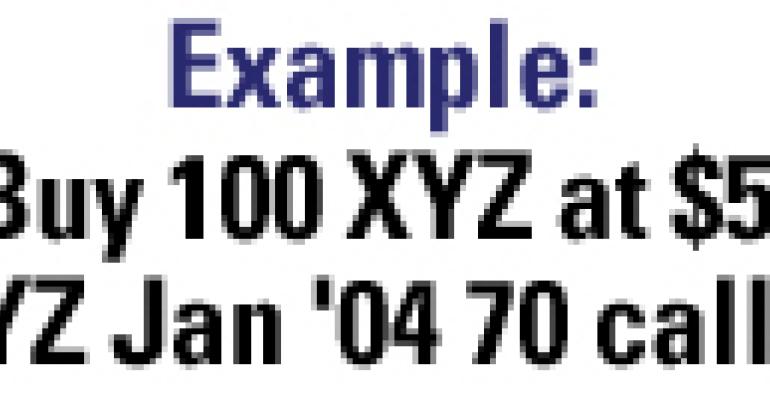Some of your clients may have asked, "what are LEAPS ?" Or maybe they asked what the difference is between selling a short-term option versus a longer-term option? LEAPS allow you to take on a longer-term approach to some traditional strategies, for example the "Covered Write". "Covered Writing" with LEAPS has prompted several questions about how the strategy works and what the risks are. Each of these questions will be addressed. ?" Or maybe they asked what the difference is between selling a short-term option versus a longer-term option? LEAPS allow you to take on a longer-term approach to some traditional strategies, for example the "Covered Write". "Covered Writing" with LEAPS has prompted several questions about how the strategy works and what the risks are. Each of these questions will be addressed. LEAPS (Long-term Equity AnticiPation Securities) are long-term options, or calls and puts with an expiration as long as thirty-nine months. Currently, equity LEAPS have two series at any time with a January expiration. The covered call write is the purchase of stock and the writing of a call on a share-for-share basis. Traditionally, it has been looked at as a short-term strategy. LEAPS, however, offer us a longer-term approach and several other benefits such as greater current income and increased downside protection. In the following pages, we will review these benefits and more. First, let's work through an example. Your client currently owns or is looking to buy 100 shares of XYZ. It is currently trading at $57. Your outlook for the stock over the next 15 months is moderately bullish. The stock does not pay a dividend. You decide to place the following trade:






XYZ above 70 at Expiration (in 15 months) Ð With XYZ at $70 or above, your client has an obligation to sell his stock at $70. Your client has a $1,300 profit from stock appreciation (strike price, 70, minus the purchase price, $57) plus a $950 profit from the call premium received for a total profit of $2,250 or an if-called return of 31.6%, not including commissions. The "If-Called" return formula is below.

XYZ is Unchanged at Expiration (in 15 months) -- Assuming no dividends and no commissions, with the stock price unchanged, the covered write makes $950 or a static return of 13.3%. What do you do now? Do you sell another call? What is your forecast for the stock, now? The calculation of the static return is below.

Stock Price Falls -- Selling the LEAPS call for $9.50 gives your client some down side protection, the purchase price, $57, less the premium, $9.50, received. XYZ's new break-even point is $47.50 or 16.7% below the current price of the stock. Below $47.50, your client has substantial risk due to stock ownership. The maximum risk is realized if the stock falls to zero.

First, what if the stock rises too much? In Graph 1, if XYZ rises above $70 at or prior to expiration, your client's participation is limited. They will only participate in the rise from $57 to $70, but above $70 they will not. You have put a ceiling on how much your client can earn. What do you do? Do you buy the call back? Do you wait to be assigned? There is no right or wrong answer but these questions should be addressed prior to implementing the strategy. Secondly, what if the stock falls too much? In Graph 1, as the stock falls in price, the covered write has long stock risk below $47.50, the new break even point. Do you buy the call back and sell the stock? Or do you wait for the call to expire, than sell another? Finally, one last consideration is early assignment. The short call contains an obligation to sell the stock at the strike price at any time prior to expiration by the call holder. Typically, this may happen around an ex-dividend date or when the stock moves in-the-money.

The goal of "covered writing" with LEAPS is to earn higher annualized percentage rates of return up and above stock ownership. Losses occur if the stock price declines sharply, and if the stock rises "too much", your client does not participate in the gain of the stock above the strike price. If all goes according to plan, then the price of the underlying stock will rise to the strike price, and the short call will expire, or accept assignment and deliver the stock, netting a $2,250 profit and a 31.6% return.
|
| Options involve risk and are not suitable for all investors. Prior to buying or selling an option, a person must receive a copy of Characteristics and Risks of Standardized Options. Copies of this document are available from your broker or The Options Clearing Corporation, 400 S. LaSalle Street, Chicago, IL 60605. CBOE and Chicago Board Options Exchange and Chicago Board Options Exchange are registered trademarks of the Chicago Board Options Exchange, Incorporated. are registered trademarks of the Chicago Board Options Exchange, Incorporated.  2002 Chicago Board Options Exchange, Incorporated, All Rights Reserved. 2002 Chicago Board Options Exchange, Incorporated, All Rights Reserved.
|











